MARIANI’S
Virtual Gourmet
May 19, 2019
NEWSLETTER
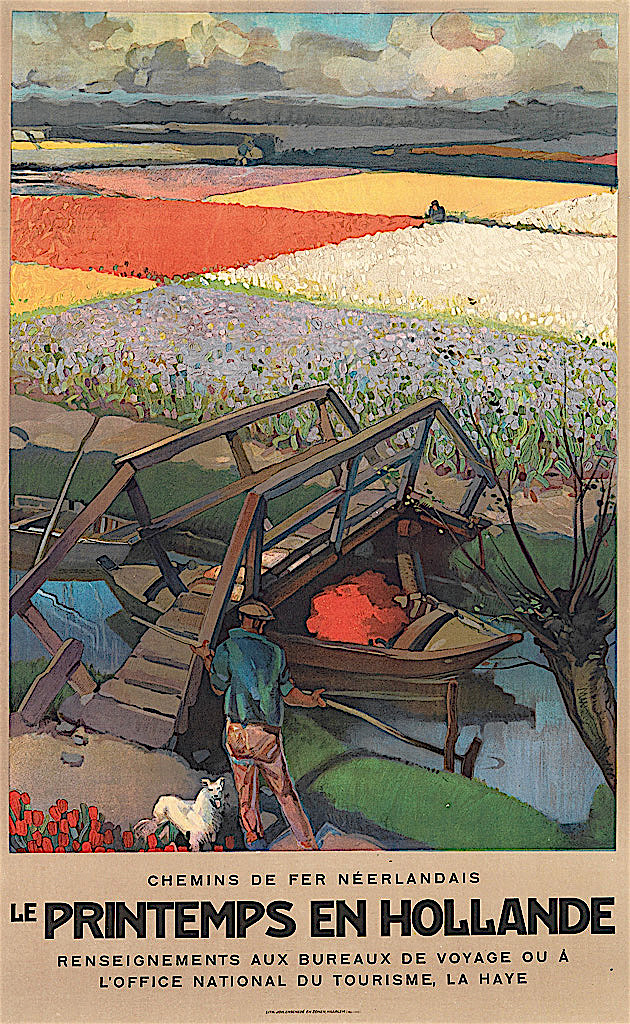
❖❖❖
IN THIS ISSUE
DINING AROUND CORAL GABLES
By Geoff Kalish
NEW YORK CORNER
LITTLE FROG
By John Mariani
NOTES FROM THE WINE CELLAR
THE ROSÉS OF CHÂTEAU MINUTY
By John Mariani
❖❖❖
DINING AROUND
CORAL GABLES
By Geoff Kalish
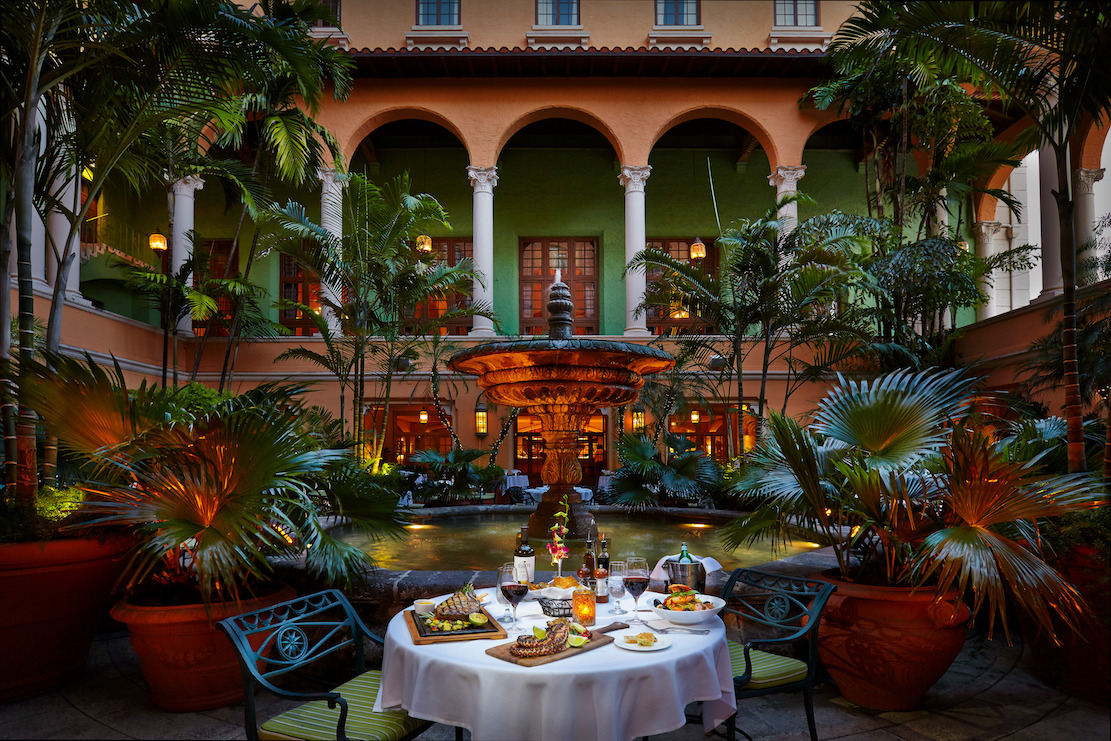
While the Miami/Coral
Gables locale offers numerous established
restaurants, like Joe’s Stone Crab, Flemings and
Morton’s, all featuring straightforward American
cuisine, upscale ethnic fare is now where the
most excitement is.
During a one-week
stay my wife and I managed to dine at five ethnic
gems. Others were not so wonderful, and suffice it
say we found the fare at La Dorada and Aromas del
Peru underwhelming.Of note, we stayed at the
historic Coral Gables Biltmore Hotel, built in
1926 by George Merrick (founder of Coral Gables),
which became a military hospital during World War
II through 1952, when it housed the Medical School
of the University of Miami until 1968, then
shuttered its doors until it became a hotel again
in 1987.
In addition to the Donald
Ross-designed, par-71 golf course, featuring wide
fairways, lots of sand traps and numerous species
of birds and reptiles (think alligators and
iguanas), the recently refurbished hotel houses
two top-tier restaurants—the haute French Palme d’
Or and the classic Italian Fontana.
Cibo
45 Miracle
Mile
305-442-4925
Located on Coral Gable’s main
drag, this restaurant offers classic as well as
modern Italian fare, with enough choices to
satisfy even the most selective diners, in an
elegantly rustic setting, with exposed brick
walls, wooden floor and trim and butcher block
tables.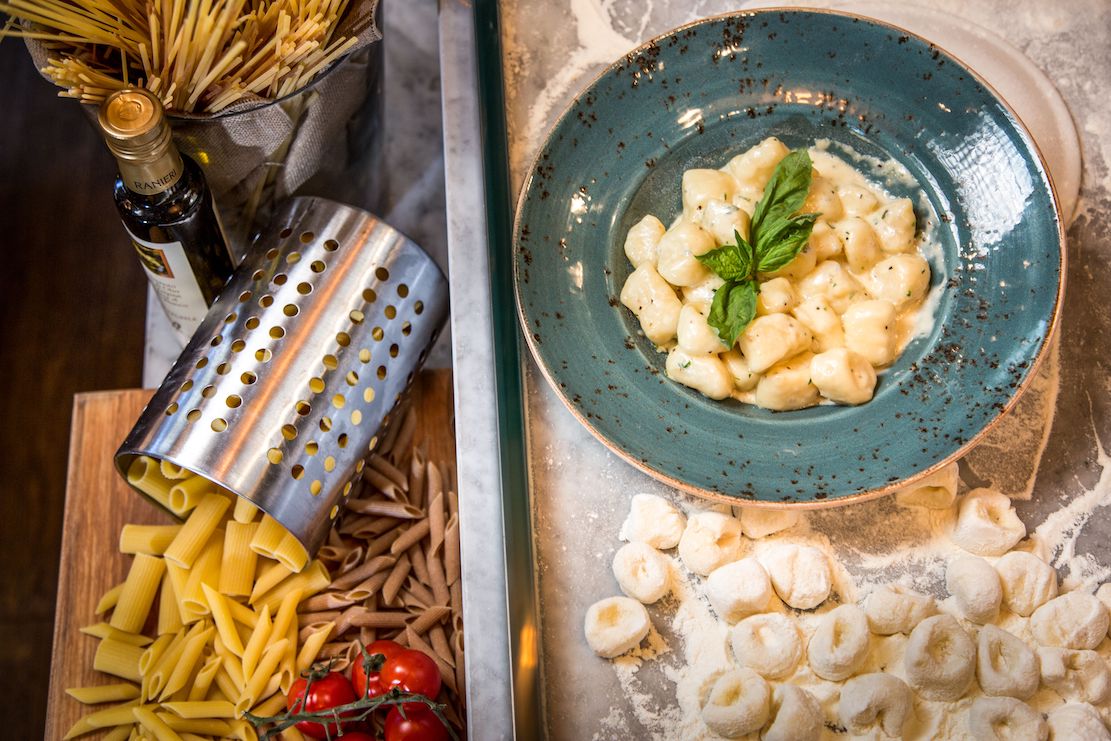
From a list of over two dozen
appetizers and salads we shared orders of tender
black tiger shrimp bathed in a spicy garlic and
tomato sauce; grilled whole calamari atop a mound
of greens and flavorful diced tomatoes, all doused
in a dressing of good oil and lemon juice;
crisp-on-the-outside, moist on-the-inside grilled
octopus mixed with purple potato chunks, green
beans, radicchio and capers; and a salad of
grilled shrimp, organic mixed greens and cherry
tomatoes. And from a list of an equal number of
pasta dishes, we shared an order of perfectly
cooked risotto chock full of fresh seafood.
Already almost full, we passed
on a choice of over a dozen and a half pizzas and
calzone.
We accompanied the meal with a bottle of
well-priced 2011 Roverone Ripasso that had
concentrated flavors of berries and spice and for
dessert couldn’t pass up the highly touted, dense
chocolate Baci bombe.
Open daily for lunch and dinner. Expect dinner for two to cost $110-$120, excluding wine, tax and tip.
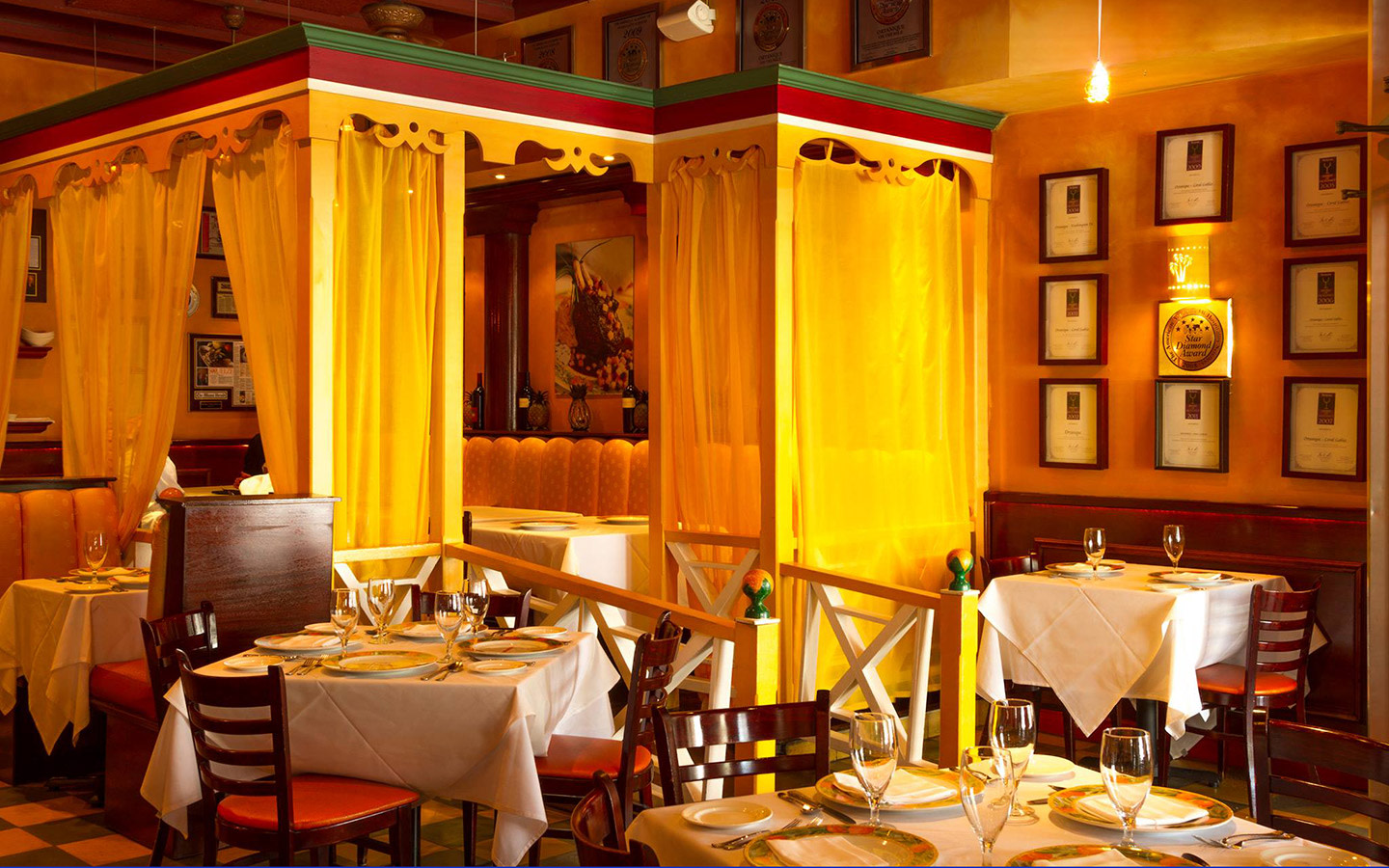 Ortanique
on the Mile
Ortanique
on the Mile
278 Miracle Mile
305-446-7710
Also located along the
Miracle Mile, this long-standing eatery with a
Caribbean bent is run by Delius Shirley and
partner/chef Cindy Hutson and her daughter Ashley.
As the name suggests, the interior walls of this
restaurant are orange, with a number of island
touches, like wooden slatted blinds, orange
flowing draperies and pillars painted with bright
vines and fruit.
Appetizers range from a large
portion of spicy tuna tartare mixed with avocado
to West Indian curried jumbo lump crab cakes, to a
salad of tender calamari lightly dusted with
Caribbean spices and tossed with a mix of greens
and tomatoes. From a choice of a dozen main
courses we selected a dewy, seared ahi tuna that
was marinated in sesame oil and heady Caribbean
herbs and spices, and accompanied by wasabi mashed
potatoes, as well as one of pan-seared salmon with
a mélange of fresh vegetables.
We accompanied the meal with
floral-scented Helfritz Gewürztraminer from Alsace
that had just the right amount of sweetness and
acidity to counter the spice of the fare. We
concluded with a slice of rich chocolate cake.
Open weekdays for lunch and dinner and Saturday and Sunday for dinner only. Expect dinner for two to cost $110-$120, excluding wine, tax and tip.
Madrid Tapas y
Vinos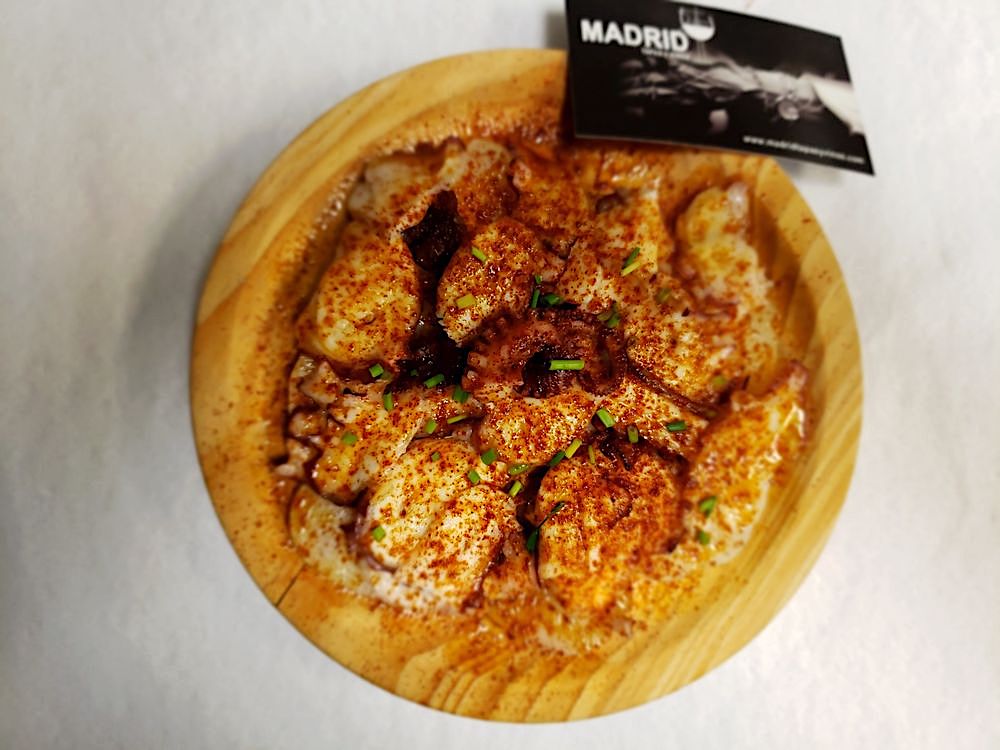
525 NW 42nd Ave., Miami
786-391-2471
Don’t let the location along
a nondescript street leading from Coral Gables to
Miami International Airport turn you off. This
restaurant serves first class, authentic Spanish
fare in a cozy room with dark wood tables and at
one end a wall of corks in front of which talented
musicians perform nightly.
We started with an appetizer of
Galician-style octopus (left), the thin slices of the
easy-to-chew mollusk atop small potato rounds
coated with a zesty, garlic-laden sauce, and an 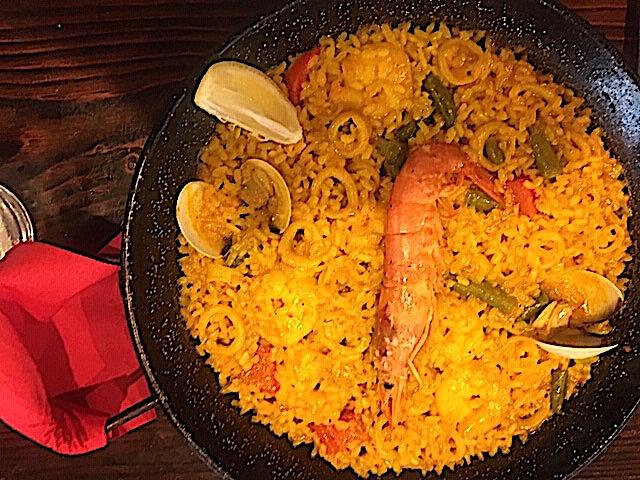 order of Gambon à la plancha—six
tender
grilled jumbo Spanish shrimps with the shells and
heads still on, providing a briny taste of the
sea. A salad of mixed greens, tomatoes and sweet
corn kernels and ripe olives was a perfect
intermezzo, which we followed with large
individual plates of paella—a paella
marisco (right),
a tasty mix of the rice with shrimps, calamari,
green beans and red pepper, and a paella negra,
rich mineral-laden black rice loaded with
octopus tentacles, shrimps, calamari and green
beans.
order of Gambon à la plancha—six
tender
grilled jumbo Spanish shrimps with the shells and
heads still on, providing a briny taste of the
sea. A salad of mixed greens, tomatoes and sweet
corn kernels and ripe olives was a perfect
intermezzo, which we followed with large
individual plates of paella—a paella
marisco (right),
a tasty mix of the rice with shrimps, calamari,
green beans and red pepper, and a paella negra,
rich mineral-laden black rice loaded with
octopus tentacles, shrimps, calamari and green
beans.
We accompanied the meal with a bottle of
2011 Ferratus Tempranillo from Ribera Del Duero
that had complex flavors of ripe plums and herbs
with hints of chocolate in its smooth finish.
For dessert we enjoyed a thick
slice of caramel-scented flan.
Open daily for lunch and dinner. Expect dinner for two to cost a very reasonable $100-$110, including tax and tip (which the restaurant automatically adds to the bill,) but not including wine.
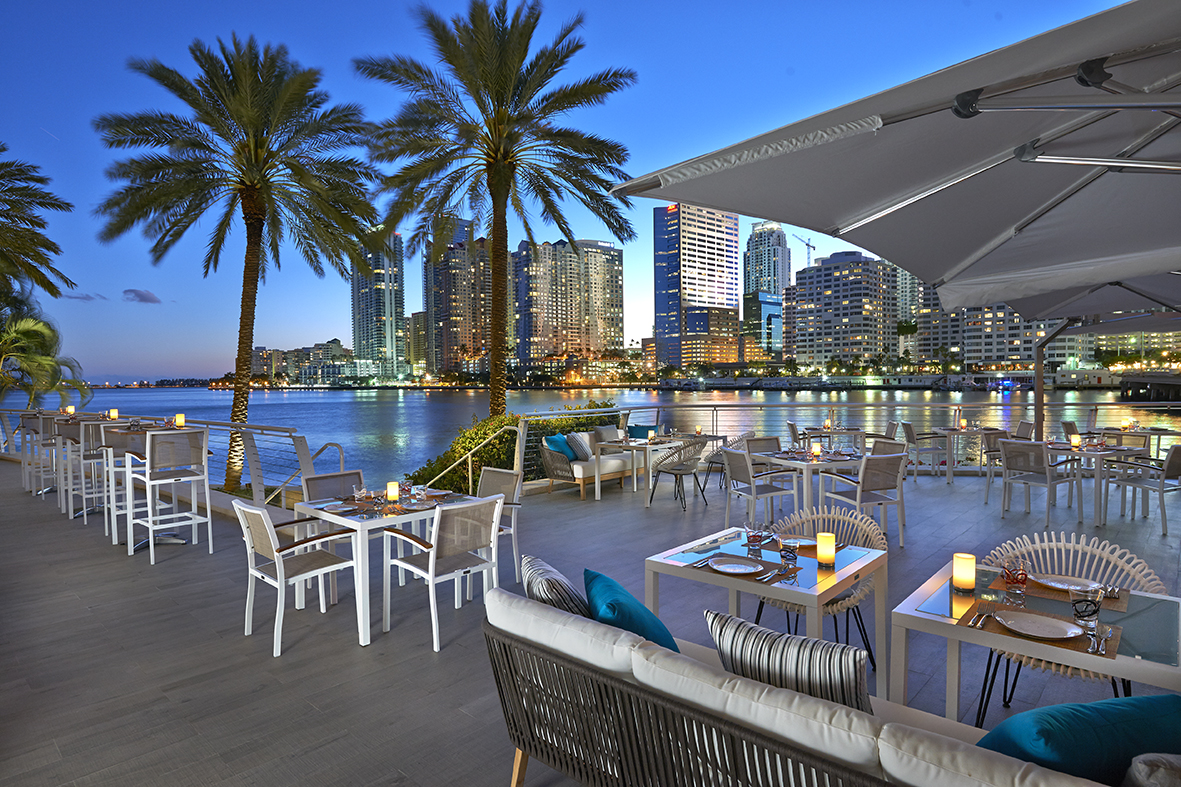 La Mar
La Mar
Mandarin Oriental Hotel
500 Brickell Key Drive
305-913-8288
Housed in the luxurious
Mandarin Oriental Hotel, which features a private
beach, an infinity pool and plush, spacious rooms,
this five-year-old restaurant offers spectacular
views of the city of Miami from the sleek indoor
dining room as well as from the popular outdoor
terrace. What’s offered is the unique Peruvian
fusion cuisine of acclaimed chef Gaston Acurio as
interpreted by Executive Chef Diego Oka.
As explained by knowledgeable,
professional servers, the 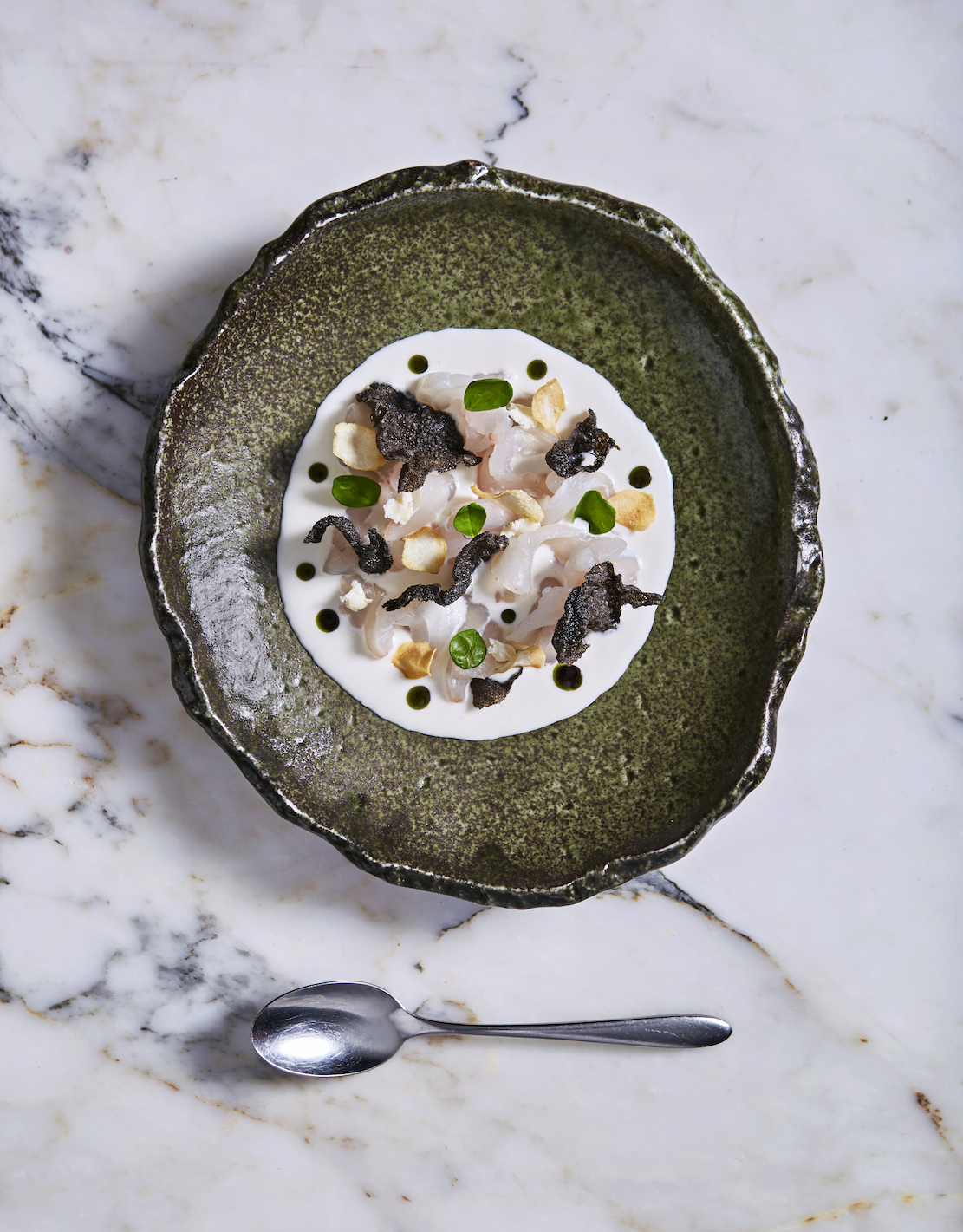 menu
features raw, slightly cooked, fully cooked and
wok-fired fare. Although the tasting menus are
popular, we choose à la carte, starting with an
order of raw seafood accompanied by smoked
heirloom tomatoes and charred Peruvian peppers
atop a tasty inky sauce, as well as two huge,
barely cooked scallops in their shells topped with
a tangy parmesan cheese foam, and one totally
cooked item—a large tender octopus tentacle coated
with a potato cream and topped by capers and
piquillo peppers.
menu
features raw, slightly cooked, fully cooked and
wok-fired fare. Although the tasting menus are
popular, we choose à la carte, starting with an
order of raw seafood accompanied by smoked
heirloom tomatoes and charred Peruvian peppers
atop a tasty inky sauce, as well as two huge,
barely cooked scallops in their shells topped with
a tangy parmesan cheese foam, and one totally
cooked item—a large tender octopus tentacle coated
with a potato cream and topped by capers and
piquillo peppers.
For main courses we chose an
order of Lomo
Saltado, a tasty stir fry of tenderloin, red
onions, tomatoes, cilantro, fried potatoes and
white rice, and a dish of succulent salmon
accompanied by a mix of bok choy, kale and
broccolini doused in a curry of coconut milk and
heady Peruvian pepper.
We accompanied
the meal with a CUNE Gran Reserva, made from
Tempranillo, Graciano and Mazuelo grapes that had
a concentrated flavor of strawberries, herbs and
oak, and concluded with a “Besso de Mar” dessert that
combined chocolate, strawberries, ricotta,
meringue, crisp quinoa and yogurt and had a good
mix of crunch and sweetness.
Open daily for lunch and dinner. Expect dinner for two to cost $130-$140, excluding wine, tax and tip.
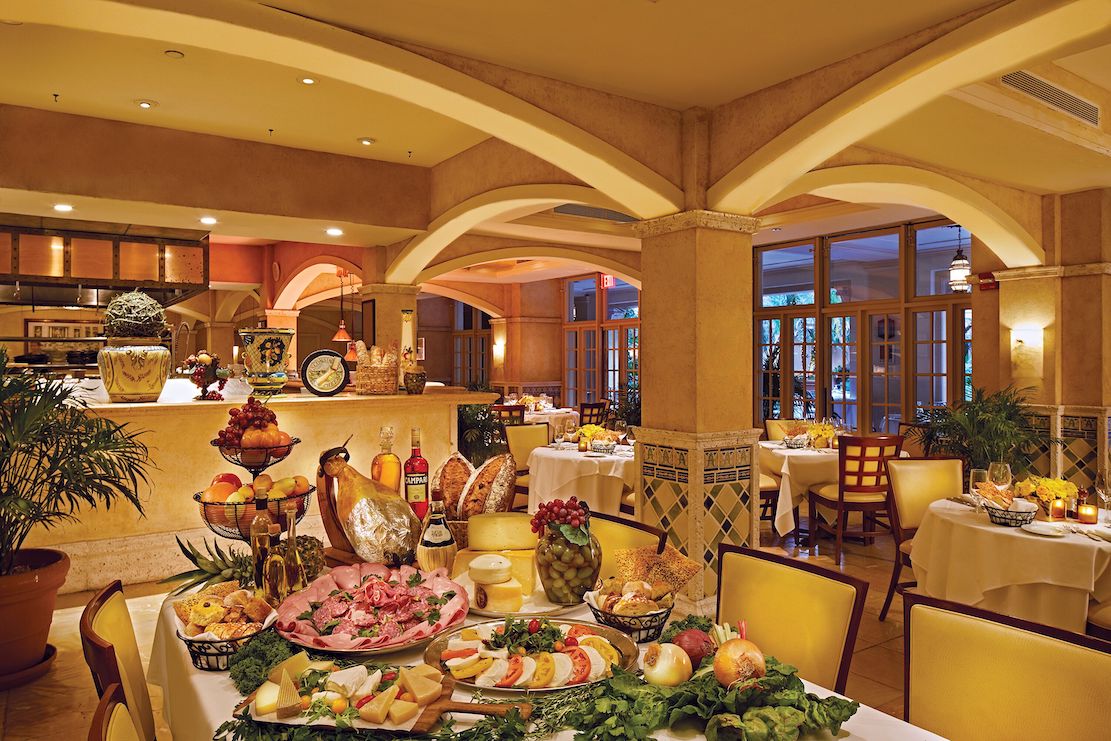 Fontana
Fontana
The Biltmore Hotel
1200 Anastasia Avenue
305-913-3189
Seating at this restaurant
is either outside in a palm-dotted courtyard
surrounding a large fountain at tables dressed in
white cloths or inside in one of a number of large
beige rooms with tiled floors and walls with
beautiful mosaics. The fare is standard regional
Italian cuisine, prepared with fresh, top quality
ingredients and a deft hand in the kitchen as
regards seasoning and the time food spent on the
grill or in the oven.
From a choice of a dozen and a
half appetizers and salads, we selected an order
of baked eggplant, mozzarella, and savory aged
Grana Padano, coated with thick tomato sauce, and
a salad of baby arugula, beets, heirloom tomatoes
and goat’s cheese dressed with a spicy lemon
vinaigrette. Our main courses, again from a large
selection of pastas, veal, chicken and seafare,
were an order of a whole wood-roasted Spanish
octopus coated in a zesty salsa verde,
and a special of moist black bass filet atop diced
vegetables. For dessert we shared a too-sweet
raspberry tart.
And, while service could have
been more attentive, the manager/sommelier was
quick to replace the wine we ordered—a 2012
Vallena Amarone—that was oxidized as well as being
served refrigerator cold, with glasses of a smooth
St. Émilion, without any charge for wine.
Open Monday-Saturday for lunch and nightly for dinner. Expect dinner for two to cost $110-$120, excluding wine, tax and tip.
❖❖❖
By John Mariani
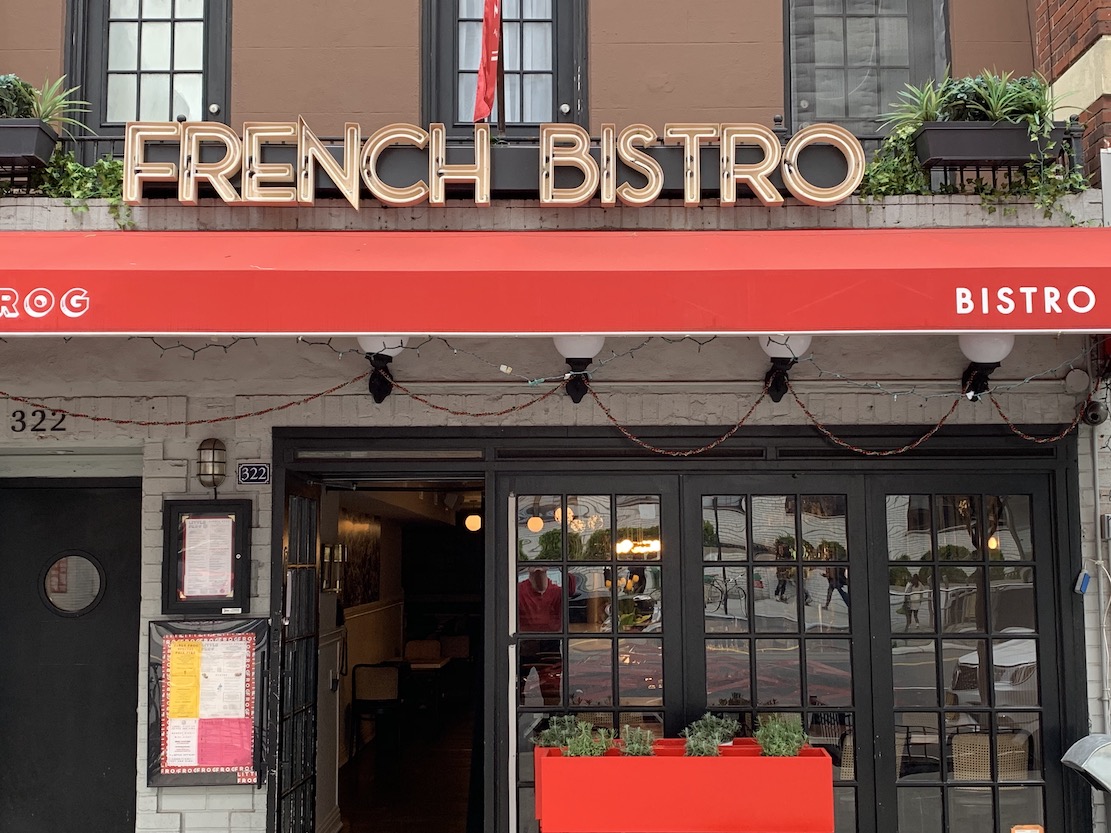
Little
Frog opened two years ago as the construction
of the Second Avenue subway dragged on and the
excavation’s noise and dust kept a lot of
people away from the restaurant. Now
that that boondoggle is finally over, Little
Frog is thriving in a Yorkville neighborhood
once crowded with French bistros with names
like Bis, Pascal, Le Boeuf à la Mode, Café du
Soir, Fleur de Lis, Le Jacques Coeur and Le
Réfuge, all now gone.
 So the
neighborhood was certainly in need of a good,
honest bistro, and François Latapie (left)
provided it, with Gallic whimsy, real comfort
and solid bourgeois cooking, via chef Xaviar
Monge. Now that the weather is turning warmer,
there are tables outside—with only the sound of
passing cars and taxis to disturb the peace.
So the
neighborhood was certainly in need of a good,
honest bistro, and François Latapie (left)
provided it, with Gallic whimsy, real comfort
and solid bourgeois cooking, via chef Xaviar
Monge. Now that the weather is turning warmer,
there are tables outside—with only the sound of
passing cars and taxis to disturb the peace.
Latapie is a veteran of New
York’s French restaurants, including a stint as
maître d’ at Le Cirque and as a partner in La
Goulue. He knows his guests well and they depend
on him and 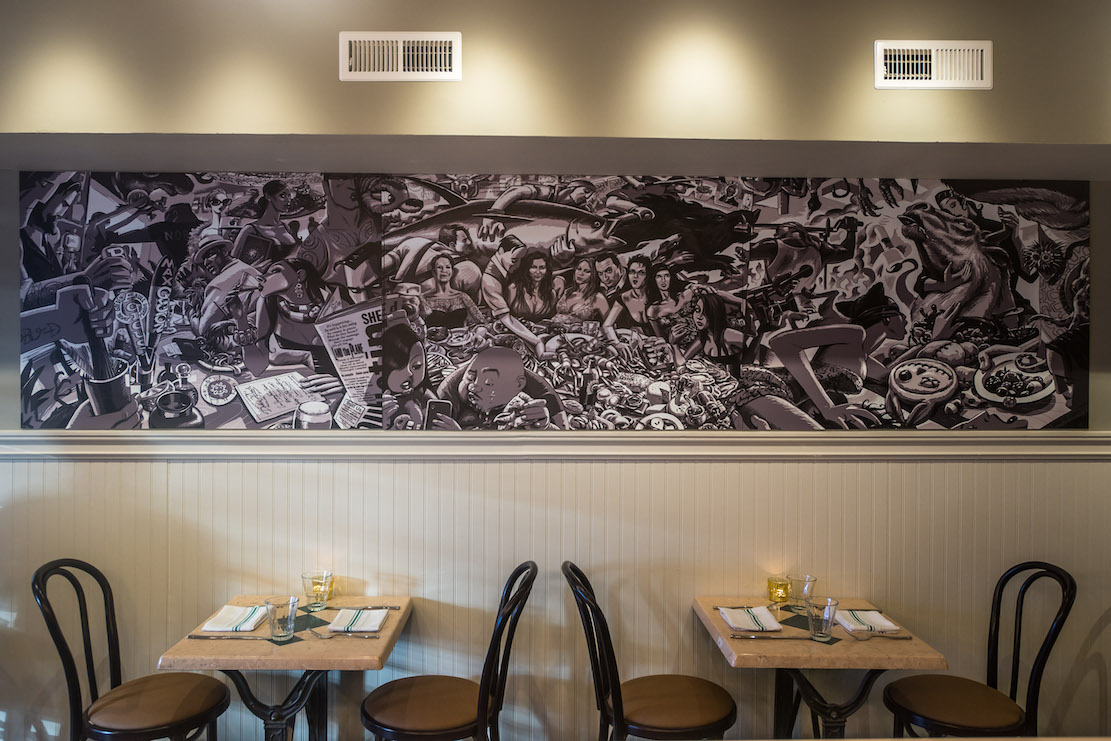 his
fleet-footed staff to recommend what’s special
each night, which currently includes the
season’s first, fattest soft-shell crabs.
his
fleet-footed staff to recommend what’s special
each night, which currently includes the
season’s first, fattest soft-shell crabs.
Little
Frog is a long room and bar with 75 seats,
done with white brick walls, green tufted
banquettes, bentwood chairs and a cosmopolitan
mural (right). You
can happily carry on a conversation with your
friends, and Latapie has gotten rid of the
canned music.
The one-page
wine list is very much geared to the style of
the food, with ten selections starred as
“Recommended” by Latapie, and plenty of bottles
under $60.
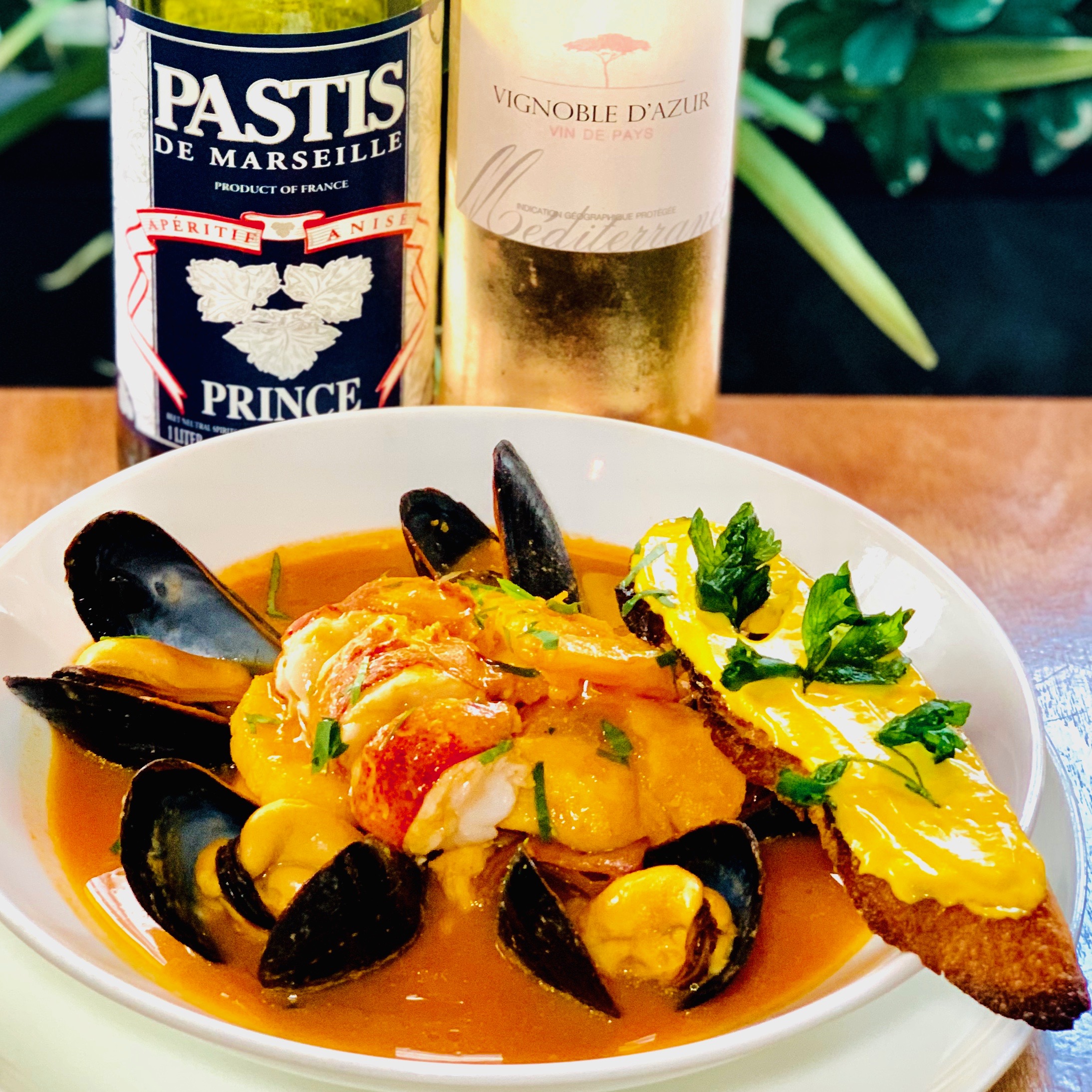 Do
order the Provençal rosemary-flecked whole-wheat
fugasse bread
($20), and you’ll probably order another. It’s
delicious.
There is also a small section of tapas
(all $10), which include slick, hot, spicy shishito
peppers to pop in your mouth, and thinly sliced
pink Iberico ham comes on a crunchy
garlic-swabbed baguette. Best of all are the
plump fritters enclosing oozing Comté cheese.
Do
order the Provençal rosemary-flecked whole-wheat
fugasse bread
($20), and you’ll probably order another. It’s
delicious.
There is also a small section of tapas
(all $10), which include slick, hot, spicy shishito
peppers to pop in your mouth, and thinly sliced
pink Iberico ham comes on a crunchy
garlic-swabbed baguette. Best of all are the
plump fritters enclosing oozing Comté cheese.
Frogs’ legs—once
a staple of French restaurants—make a welcome
re-appearance at Little Frog, nicely garlicky,
sprinkled with parsley and served
with spring’s ramps and asparagus ($17).
The duck parfait is as rich and creamy as ever,
given 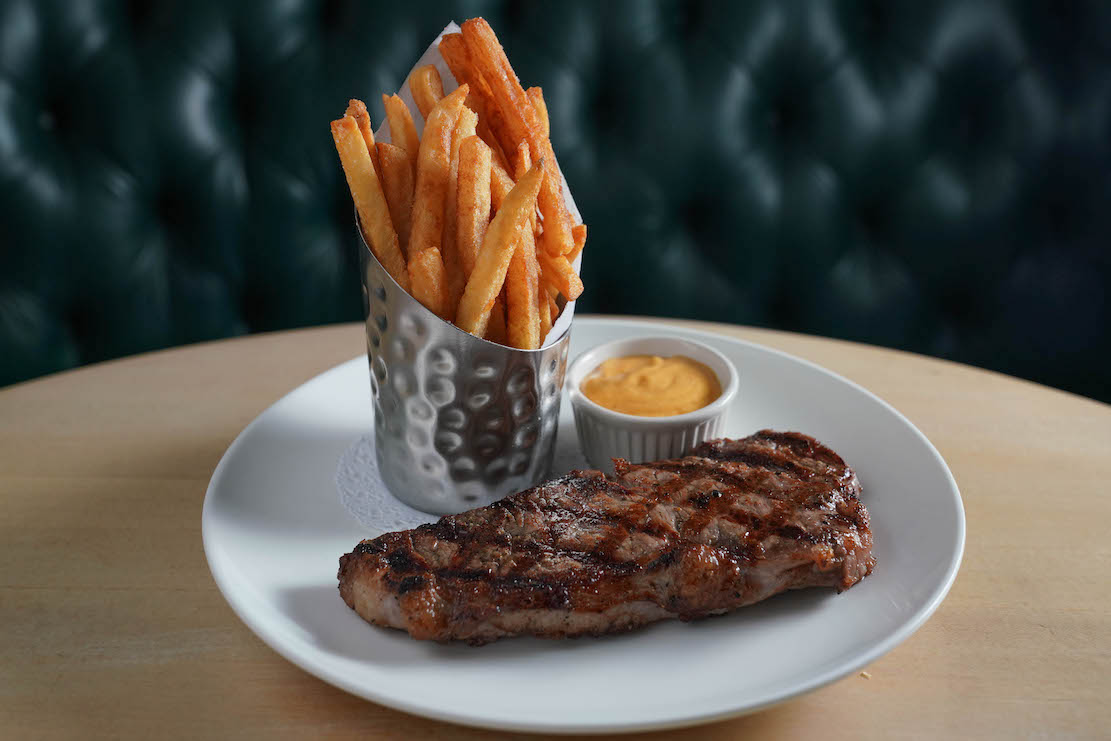 sweet-sour
inflections from brandied cherries, served on a
baguette with cornichons. Little
Frog’s onion soup gratinée
is still one of the best in town, with a deep,
dark mahogany broth and plenty of bubbling,
browned Gruyère on top. Bouillabaisse has all
the right shellfish in a ruddy, Pastis-scented
broth with garlic mayonnaise rouille (above).
sweet-sour
inflections from brandied cherries, served on a
baguette with cornichons. Little
Frog’s onion soup gratinée
is still one of the best in town, with a deep,
dark mahogany broth and plenty of bubbling,
browned Gruyère on top. Bouillabaisse has all
the right shellfish in a ruddy, Pastis-scented
broth with garlic mayonnaise rouille (above).
The specialty of the house,
which I did not try this time, is worth knowing
about: a whole Normandy duck seasoned with Asian
spices with a bourbon-orange sauce that is
flambéed, and a side of spinach and kumquats
($79 for two).
The onglet cut
of steak has been replaced with a 10-ounce New
York strip (above),
with an abundance of French fries in a paper
canister, at a very reasonable $35. The beef has
a pleasing chewiness to it, as it should. For
two bucks more, you can have it with a sauce au poivre. Currently there
is a whole grilled dorade with Provencal tomato
and olives ($29), and they always have mussels
with frites
($26).
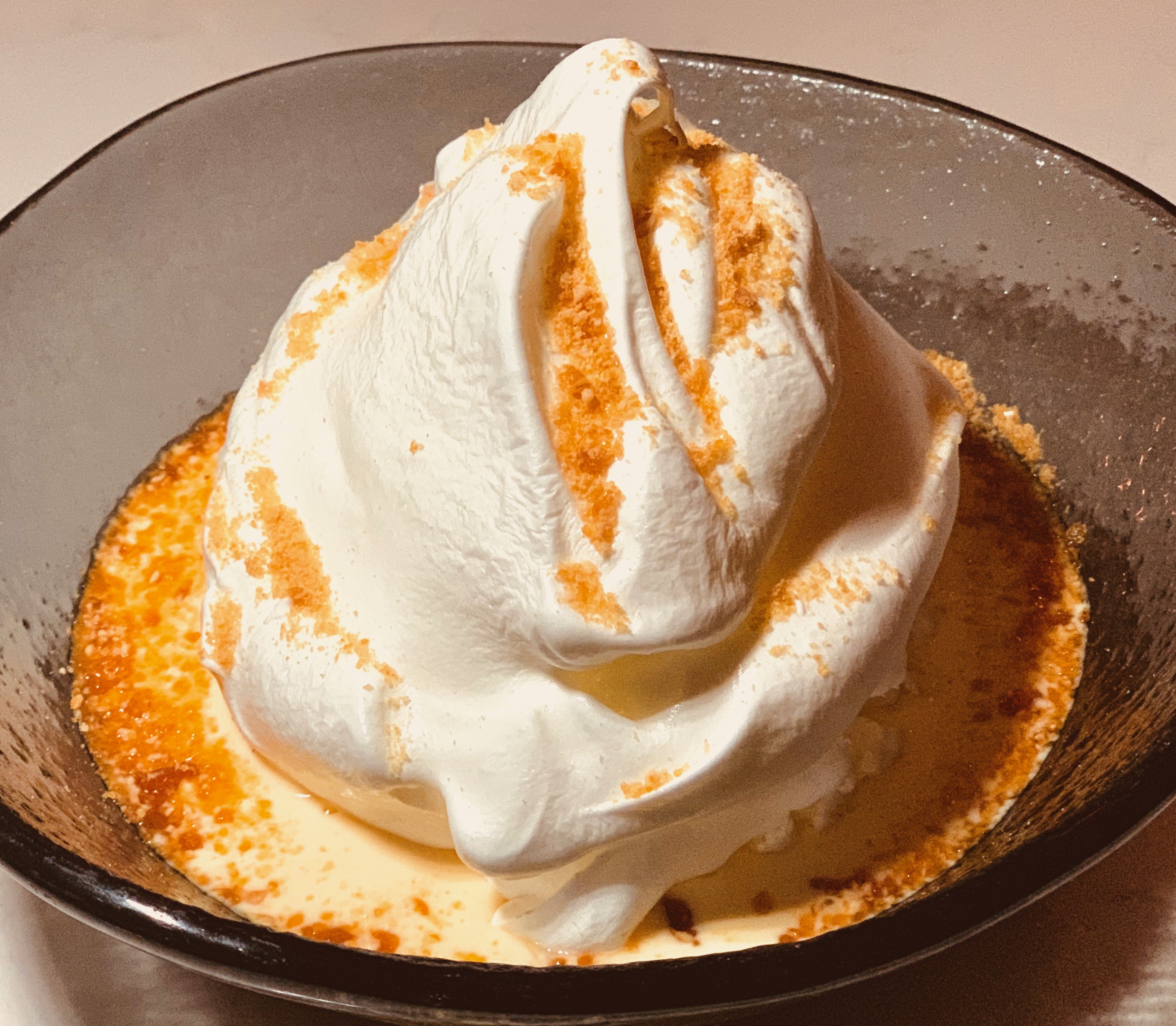 For dessert my
favorite is the big bowl of oeufs à la
neige, or île
flottante (floating island), as light as
spun sugar with a rich crème anglaise (left). Last
time I ordered the apple tart, it was
undercooked and the pastry mushy; this time it
was overcooked and the pastry needed a sharp
knife to get through. Practice has not yet
yielded perfect results on this item.
For dessert my
favorite is the big bowl of oeufs à la
neige, or île
flottante (floating island), as light as
spun sugar with a rich crème anglaise (left). Last
time I ordered the apple tart, it was
undercooked and the pastry mushy; this time it
was overcooked and the pastry needed a sharp
knife to get through. Practice has not yet
yielded perfect results on this item.
Aside
from that, Little Frog has hit its buoyant
stride, and Latapie is eagerly waiting for a
tall condo to open across the street to bring in
a new crowd of what will inevitably become
regulars.
I hope he saves some place for us old
regulars who don’t live in the neighborhood and
those who have yet to find it. Little
Frog is worth searching out.
Open for dinner nightly, for brunch Sat. & Sun. There is a three-course, fixed price dinner with wine for $29 from 5 to 6 p.m. nightly.
CHÂTEAU MINUTY
By John Mariani
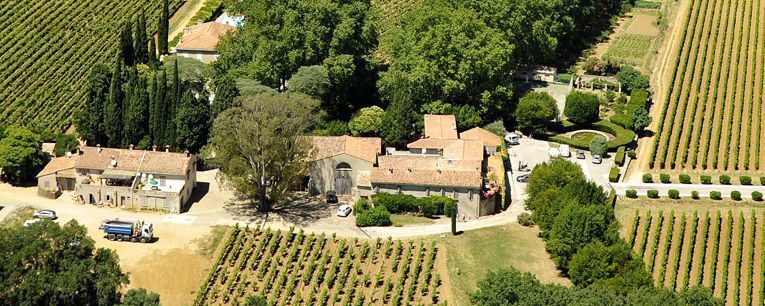
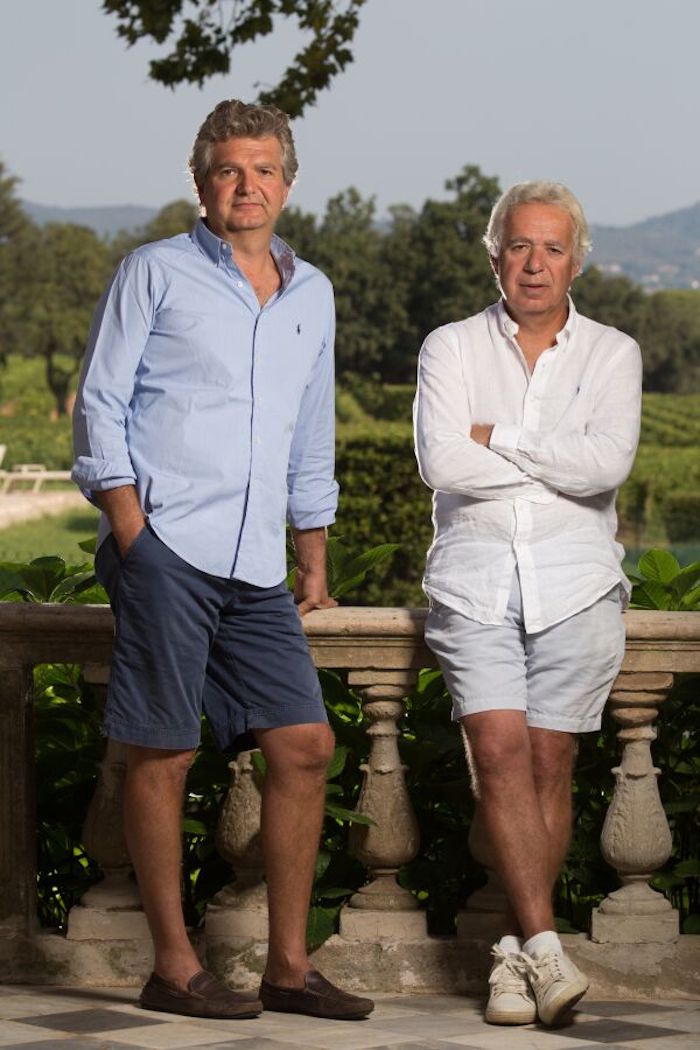 If anyone could be
called a crusader for rosé wines, it’s Matton,
who makes it clear that people who drink rosé
only in spring and summer are denying themselves
the pleasure of a fresh, brisk, acidic aperitif
at any time of year. Most of his wines, which
come from estates in and around Gassin, near
Saint Tropéz, are harvested in the fall and
released the following spring, which is why we
were drinking the just-released 2018 vintage.
If anyone could be
called a crusader for rosé wines, it’s Matton,
who makes it clear that people who drink rosé
only in spring and summer are denying themselves
the pleasure of a fresh, brisk, acidic aperitif
at any time of year. Most of his wines, which
come from estates in and around Gassin, near
Saint Tropéz, are harvested in the fall and
released the following spring, which is why we
were drinking the just-released 2018 vintage.
I asked him straight out what
seems both a foolish yet wholly reasonable
question: Why make rosés at all, since the
grapes commonly grown in Provence—Grenache,
Cinsault and Syrah—are all red? Matton, 50, who
is a third-generation vigneron of the
Matton-Farnet family, made a typical French pout
and said, unequivocally, “I do not use
red grapes to make my wines. I use rosé grapes!”
He explained that those three red grapes are
intended by nature and the terroir to make good
rosé wines, rather than mediocre reds. (The
estate does also make red and 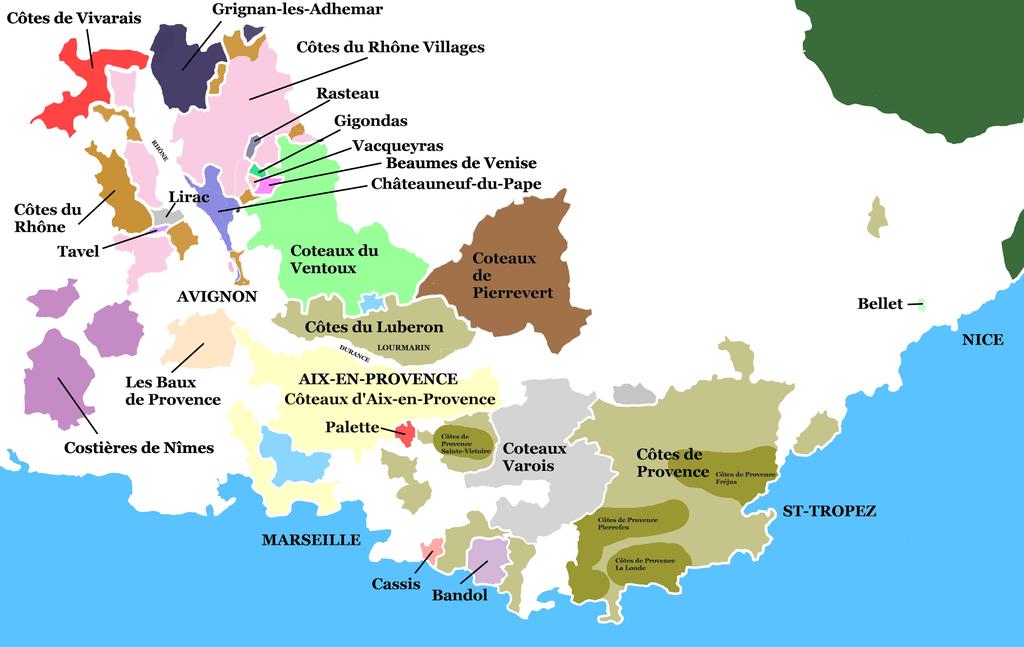 white wines.)
white wines.)
“Our wines go perfectly with
our food,” he says. “We are on the
Mediterranean, close to Italy, and the seafood,
fruits, herbs and spices we use need an acidic,
delicate wine to go with dishes like
bouillabaisse, pissaladière, tapenade and
aïoli. We use olive oil, garlic, tomato, fennel,
basil and thyme in our cooking. You don’t want
to drink a red wine with such food.”
His point was well taken, not
least because the aromas and flavors of Provence
are vividly evident in rosé wines. One can smell
a bouquet of roses, hyacinth and lavender, and
they taste of sage and olives and rosemary. They
come in a wide range of pastel colors, from very
pale gold to burnished pink. Some are very dry,
and others very floral. The best will indeed
have that brisk acidity and the alcohol will
rarely be above 13 percent.
“If you don’t drink rosé
within the year,” said Matton, “the acid
decreases and, although the alcohol doesn’t get
any higher, the wine will seem heavier and lose
its freshness.”
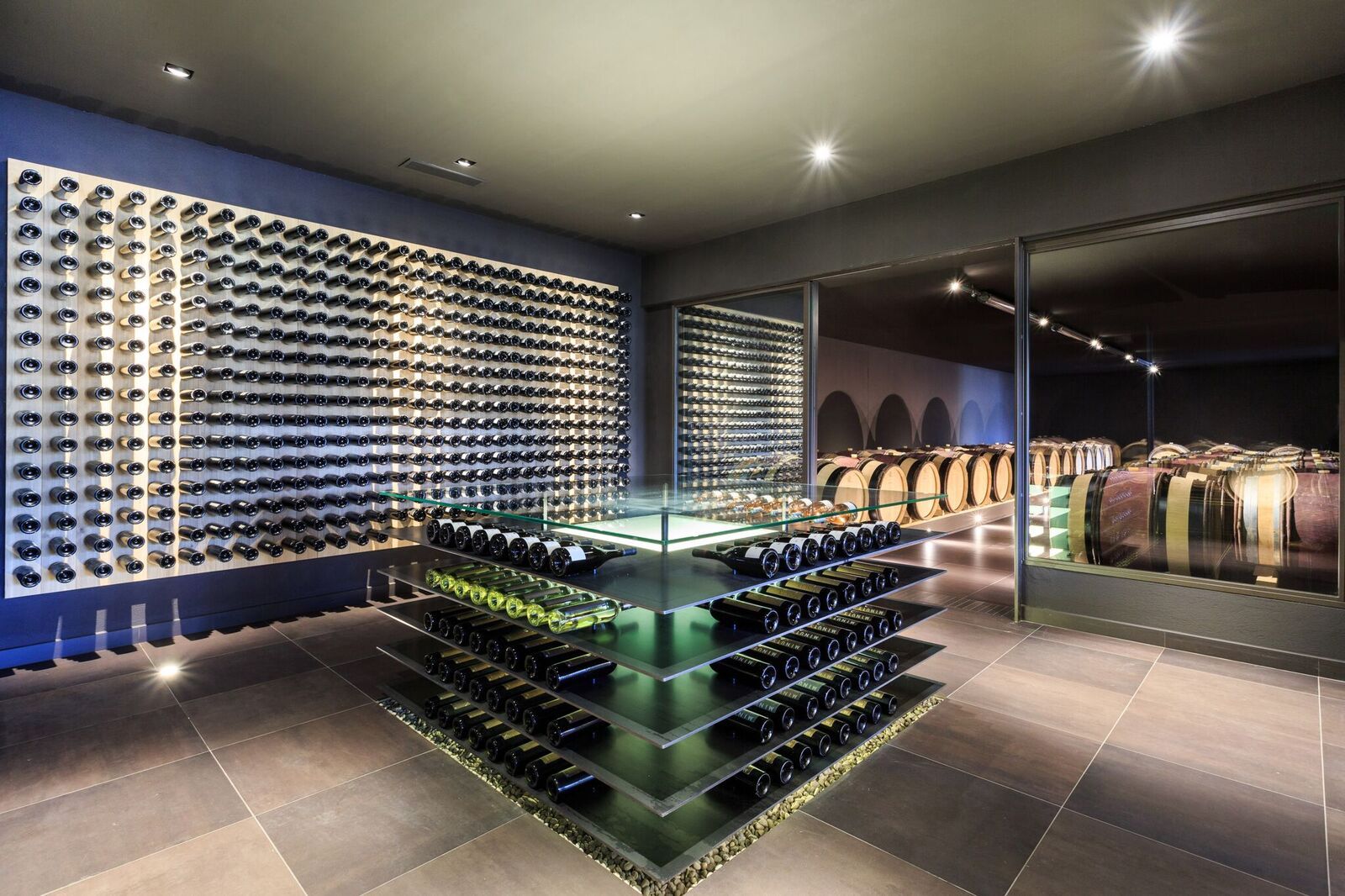 The
80-year-old company produces a lot of
wine—600,000 cases—and is also a distribution
company for others’ wines. Recently Matton and
his brother Jean-Étienne have worked to
restructure the vineyards, replacing Carignan
and Ugni Blanc grapes with Grenache and Rolle,
and modernizing the winery and tasting rooms for
visitors. Their wines are now sold in 75
countries, with the U.S. taking 10% of the
exports. They
are also very involved in clonal research, using
a proprietary clone for their finest estates.
The
80-year-old company produces a lot of
wine—600,000 cases—and is also a distribution
company for others’ wines. Recently Matton and
his brother Jean-Étienne have worked to
restructure the vineyards, replacing Carignan
and Ugni Blanc grapes with Grenache and Rolle,
and modernizing the winery and tasting rooms for
visitors. Their wines are now sold in 75
countries, with the U.S. taking 10% of the
exports. They
are also very involved in clonal research, using
a proprietary clone for their finest estates.
I asked him if his rosés,
which do not need aging, would be better off
with non-cork closures. Matton leaned towards me
and said, “To be honest, yes. We already use
screwcaps for bottles we ship to Scandinavia,
Australia and New Zealand. But
the rest of the market is not ready for them.”
We drank three wines, all
from 2018, over a dinner that included a good
deal of seafood like soft-shell crabs, golden
snapper and Dover sole. The first was the “entry
level rosé,” called M de Minuty ($21), a blend
of Grenache, Cinsault and Syrah, which served as
a bracing aperitif. Matton said he thinks this
wine should be served cold and is not against
plopping ice cubes in this wine in warm weather.
The wine 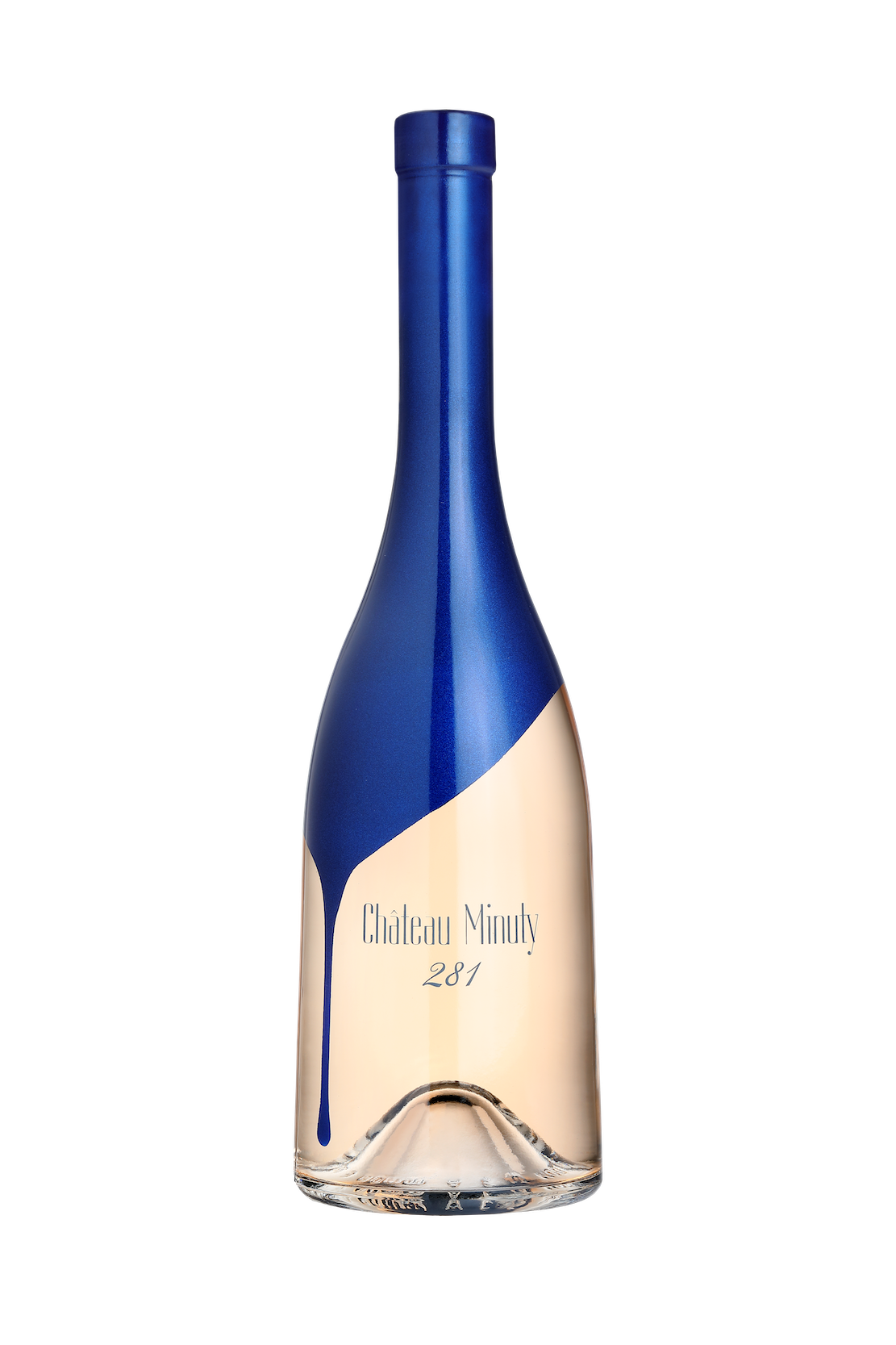 is in
the now-familiar shapely bottle for Provence.
There is also a limited edition of this same
wine in a new bottle (at $23). The alcohol is
12.5%.
is in
the now-familiar shapely bottle for Provence.
There is also a limited edition of this same
wine in a new bottle (at $23). The alcohol is
12.5%.
The next wine, enjoyed with
the first course, was called Rose et Or ($40), a
blend of Grenache, Cinsault and Tibouren, which
had more finesse and body, of which Matton said,
“The aroma of this wine is of the white peach
that grows in the region.”
The third wine was another
step up in refinement and complexity of flavors,
adding pear to the peach notes. It is
called 281 ($79)—which has no mysterious meaning
other than being the number on the international
standard chart for a royal blue (right) that
designer Hubert de Malherbe used for the unique
bottle (he also does Dior’s perfume bottles).
It is made from a single
clone developed by Matton’s grandmother and from
vines that average 25 years old. The Grenache
and Syrah grapes are hand harvested and free-run
juice is used. The alcohol is 12.5%. Production
is 35,000 bottles.
Overall
sales of rosés have been booming, with plenty of
novelties being made in California, and many
traditional examples pouring out of Spain and
Italy. But it’s tough to convince Matton that
nature favored any other territory outside of
Provence with the perfect conditions to make
great rosé.
❖❖❖
 ODDEST POP REFERENCE IN A
RESTAURANT REVIEW IN 2019 (SO FAR)
ODDEST POP REFERENCE IN A
RESTAURANT REVIEW IN 2019 (SO FAR)
"There is a sequence of scenes
in Batman Begins in which Bruce Wayne goes
to a remote dojo in the mountains. There, apart from
society, Wayne can leave behind the bustle to focus and
train. By the time he returns to Gotham, Wayne is
Batman. In early 2018, Dom Ruggiero left Chelsea’s
Kitchen for an 827-square-foot butcher shop in Carefree.
. . . After nine
months away from the restaurant kitchen, Ruggiero
returned in February. And if you have eaten at his new
restaurant, Hush Public House, you probably know that if Ruggiero
wasn’t Batman before he went away to cure salumi and
carve oyster steaks, he is definitely Batman now.
MUST BE
COMPETITIVE AT KARAOKE
A London-based company named HushHush posted a job
opening seeking someone to test luxury yachts to ensure
the luxury yachts listed on the e-commerce site meet
high standards. The
job will entail spending a week on the boat to evaluate
"every plug socket, door, bed, shower, tap -- everything
to make sure that the yacht is up to our standards." The
job pays $1,300 per yacht review, and candidates could
potentially inspect up to 50 yachts per year and collect
up to $65,000. The listing states no previous yacht
experience is required.
Wine
Column Sponsored by Banfi Vintners
SANGIOVESE
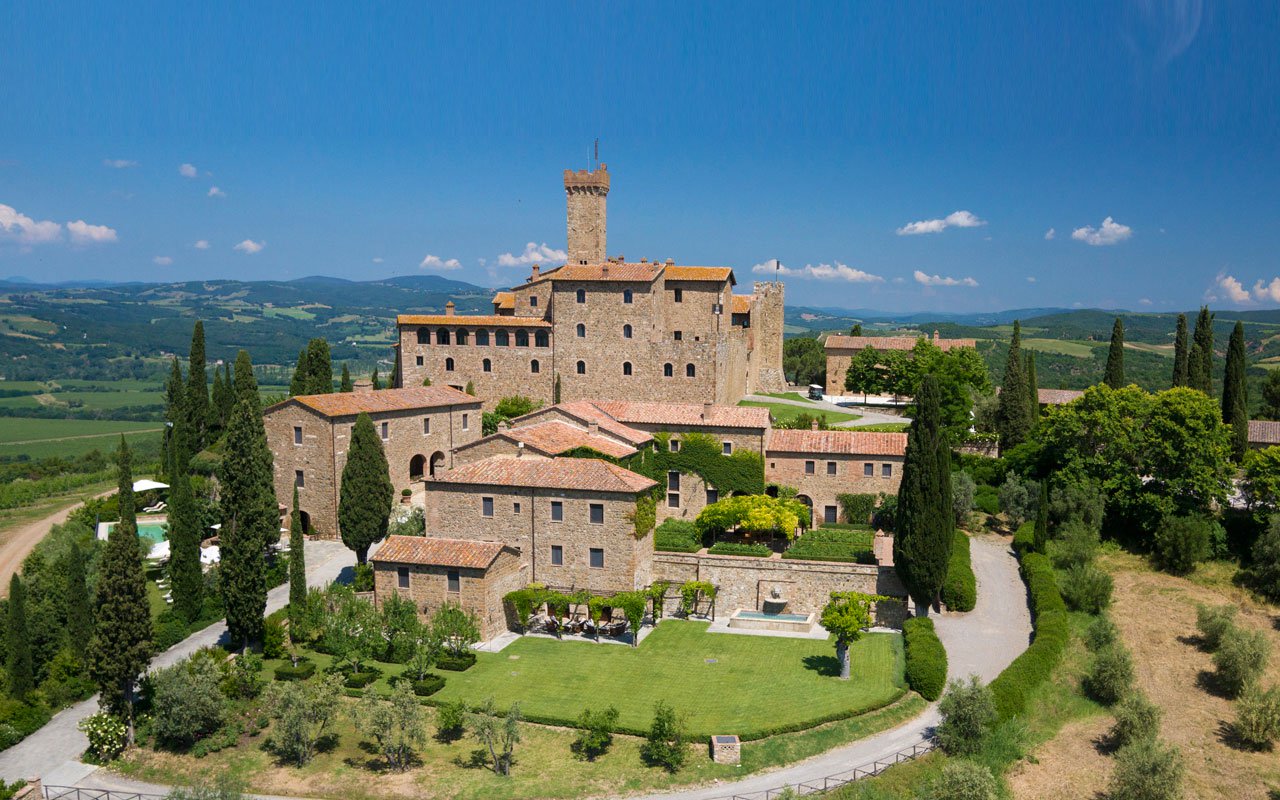 Wine is a joy year-round but
in cooler weather one
grape varietal has really taken center stage in
my daily activities – that most Italian of
grapes, Sangiovese, and its ultimate expression
– Brunello di Montalcino.
Wine is a joy year-round but
in cooler weather one
grape varietal has really taken center stage in
my daily activities – that most Italian of
grapes, Sangiovese, and its ultimate expression
– Brunello di Montalcino.
From mid-September through mid-October,
the Sangiovese grown for our various styles of red
wines are be harvested, culminating with the top
selection for Brunello di Montalcino.
Second, cooler weather here means
it is time to start enjoying more red wines and
especially Sangiovese based wines. That
includes Banfi’s cru of Brunello, Poggio alle Mura,
literally the cream of the crop of our Sangiovese
vineyards. Alongside our Poggio alle Mura Brunello di
Montalcino, this year we introduced two more wines
from the cru Poggio alle Mura – a Rosso di Montalcino
and a Riserva of Brunello. Rosso is sort of like the
younger brother of Brunello, also made from 100%
Sangiovese grapes but usually a selection from younger
vines and the wine is aged only two years compared to
the four required for Brunello. The
Riserva, on the other hand, is an even more selective
harvest of Sangiovese, and ages for an additional year
before release.
What is so special about this cru
Poggio alle Mura?
Well, it is the result our over 30 years of
ongoing research at my family’s vineyard estate,
Castello Banfi.
When we first began planting our vines there in
the late 1970s studies from the University of Bordeaux
indicated which strains of many varietals we should
plant, based on the soil type and microclimate of each
vineyard. But
when it came to the region’s native Sangiovese, there
was only local lore, no scientific research. So we took
it upon ourselves to figure out this vine, and set off
on three decades of incredibly detailed research.
We started
with 600 apparent variations on Sangiovese, because it
is so susceptible to variations in weather and soil,
and narrowed that down to 160 truly genetically
different clones.
We planted a vineyard with two rows of each
type, made wine from each of them, and charted the
differences – remember, you only get one chance a year
to make wine, so this took time.
It took about ten years to get some
concrete results, though we continue to experiment
today and always will – you never stop learning in
science and nature!
Once we determined which were the best,
complementary clones that could be planted together to
make the best Brunello, we chose to plant them in what
we determined to be the optimal vineyard sites. Coincidentally,
the best soils and climate conditions are in the
slopes surrounding the medieval fortress today known
as Castello Banfi, known since Etruscan times as
Poggio alle Mura – the walled hilltop. Hence the
name of our most special “cru” of Brunello,
representing a synthesis between tradition and
innovation.
Though the focus of this study was
our Brunello, all of our Sangiovese-based wines,
including the super Tuscans SummuS, Cum Laude, and
Centine, benefitted from this work. And that’s
the third reason for celebrating Sangiovese this
month, for the range of wonderful reds that usher us
into autumn! One
wine in particular was inspired by our research – the
BelnerO, a Sangiovese dominant blend with what I like
to call a kiss of Cabernet and a whisper of Merlot. We grow the
grapes a little differently for BelnerO than for
Brunello, make the wine with less oak aging and
released it earlier from the winery, providing a
counterpoint to Brunello and a lovely terroir-driven
wine in its own right.
If you
know Italians, you know that by nature we are
multi-faceted, varying in mood, and always passionate. As a
nation, we span from the hot sunny beaches of Sicily
near the African coast to the rugged mountains and
Alpine ski slopes of Trentino-Alto Adige in the north. Sangiovese
is grown in almost all of Italy’s regions and reflects
the unique nature of each; it is most famous
(rightfully so) in Tuscany, yet even there it reflects
the nuances of each hilltop, valley and subzone. It has
something a little different to say in Brunello than
Chianti, Morellino than Vino Nobile di Montepulciano,
Rosso di Montalcino than Super Tuscan blends.
Here is a smattering of
Sangiovese-based wines that you may wish to get to
know better, reflecting a spectrum that appeals to
every occasion, every taste, and every budget. We can
assure you that the conversation will never become
boring. 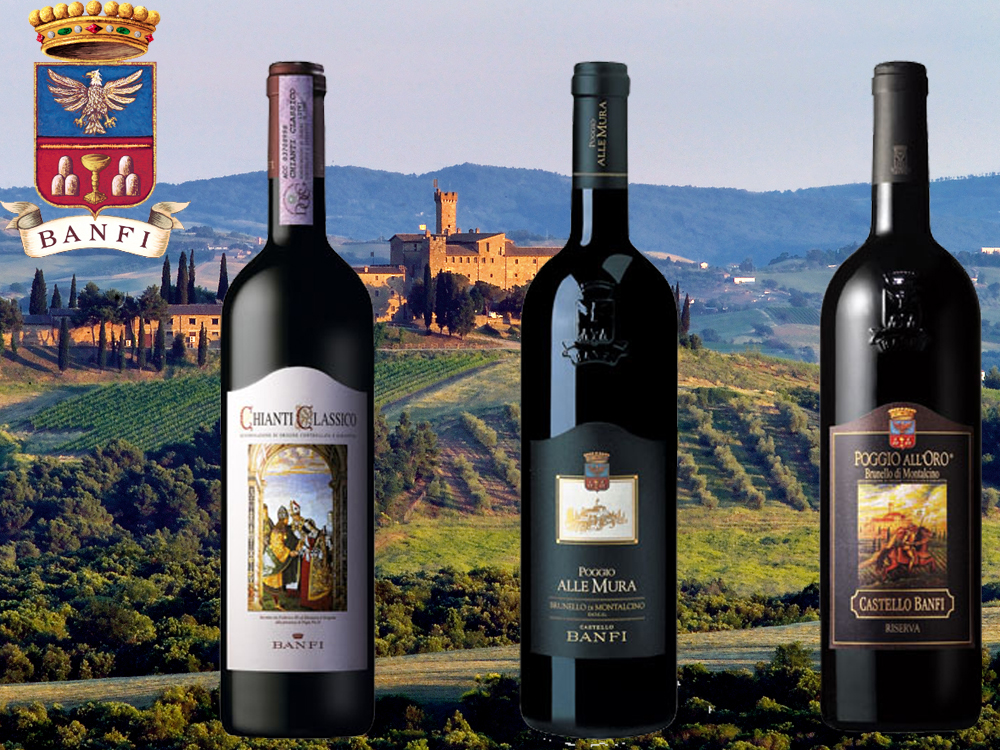
Recommendations for Celebrating
Sangiovese
BelnerO Proprietor’s Reserve Sangiovese
– A refined
cuvée of noble red grapes perfected by our pioneering
clonal research. This dark beauty, BelnerO, is
produced at our innovative winery, chosen 11
consecutive years as Italy’s Premier Vineyard Estate.
Fermented in our patented temperature controlled
French oak and aged approximately 2 additional years.
Unfiltered, and Nitrogen bottled to minimize sulfites.
Castello Banfi Brunello di Montalcino –
Rich, round, velvety and intensely
aromatic, with flavor hints of licorice, cherry, and
spices. Brunello di Montalcino possesses an intense
ruby-red color, and a depth, complexity and opulence
that is softened by an elegant, lingering aftertaste.
Unfiltered after 1998 vintage.
Castello Banfi Rosso di Montalcino – Brunello's "younger brother," produced
from select Sangiovese grapes and aged in barrique for
10 to 12 months. Deep ruby-red, elegant, vibrant,
well-balanced and stylish with a dry velvety
finish.
Poggio all’Oro Brunello di Montalcino
Riserva – A single vineyard selection of our most
historically outstanding Sangiovese, aged five years
before release, the additional year more than that
required of Brunello including 6 months in barrel and
6 months more in bottle to grant its “Riserva”
designation. Incredible
elegance and harmony. Intense with lots of fruit and
subtle wood influence. Round, complete, well balanced
with hints of chocolate and berries. Unfiltered after
1998.
Poggio alle Mura – The first tangible result of years of
intensive clonal research on Montalcino’s native
Sangiovese grape.
Estate bottled from the splendidly sun drenched
vineyards surrounding the medieval Castello from which
it takes its name.
The Brunello
di Montalcino is seductive, silky and smoky. Deep ruby
in color with an expressive bouquet of violets, fruits
and berries as well as cigar box, cedar and exotic
spices. The Rosso
di Montalcino is also intense ruby red. The bouquet
is fresh and fruity with typical varietal notes of
cherry and blackberry, enriched by more complex hints
of licorice, tobacco and hazelnut. It is full
bodied, yet with a soft structure, and a surprisingly
long finish. The Poggio alle Mura Brunello di Montalcino
Riserva is deep ruby red with garnet
reflections and a rich, ample bouquet that hints of
prune jam, coffee, cacao and a light balsamic note. It is full
and powerful, with ripe and gentle tannins that make
it velvety and harmonious; this wine is supported by a
pleasing minerality that to me speaks soundly of that
special hillside in southern Montalcino.
SummuS – A wine of towering elegance, SummuS is an
extraordinary blend of Sangiovese which contributes
body; Cabernet Sauvignon for fruit and structure; and
Syrah for elegance, character and a fruity bouquet. An elegant,
complex and harmonious red wine.
Cum Laude – A complex and elegant red which graduated
“With Honors,” characterized by aromas of juicy
berries and fresh spices.
Centine – A Cuvee that is more than half
Sangiovese, the balanced consisting of equal parts of
Cabernet Sauvignon and Merlot. Vinified in
a firm, round style that easily accompanies a wide
range of dishes, this is a smooth and fragrantly
satisfying wine with international character, and a
perennial favorite at my own dinner table.
Banfi Chianti Superiore – The “Superiore” designation signifies
stricter government regulations regarding production
and aging requirements, as compared to regular
Chianti. An
intense ruby red wine with fruit forward aromas and
floral notes. This
is a round wine with well-balanced acidity and fruit.
Banfi Chianti Classico – An enduring classic: alluring
bouquet of black fruit and violets; rich flavors of
cherry and leather; supple tannins and good acidity
for dining.
Banfi Chianti Classico Riserva – Produced from select grapes grown in the
"Classico" region of Chianti, this dry, fruity and
well-balanced red has a full bouquet reminiscent of
violets.
Fonte alla Selva Chianti Classico – This is our newest entry into the Chianti
arena, coming from a 99 acre estate in Castellina, the
heart of the Chianti Classico region. The wine is
a captivating mauve red that smells of cherry, plum
and blackberry with hints of spice. It is
round, full and balanced with very good
acidity.
Col di Sasso – Sangiovese and Cabernet Sauvignon. Luscious,
complex and soft with persistent notes of fruit and
great Italian style structure.
Any of John Mariani's books below may be ordered from amazon.com.
 The Hound in Heaven
(21st Century Lion Books) is a novella, and
for anyone who loves dogs, Christmas, romance,
inspiration, even the supernatural, I hope you'll find
this to be a treasured favorite. The story
concerns how, after a New England teacher, his wife and
their two daughters adopt a stray puppy found in their
barn in northern Maine, their lives seem full of promise.
But when tragedy strikes, their wonderful dog Lazarus and
the spirit of Christmas are the only things that may bring
his master back from the edge of despair.
The Hound in Heaven
(21st Century Lion Books) is a novella, and
for anyone who loves dogs, Christmas, romance,
inspiration, even the supernatural, I hope you'll find
this to be a treasured favorite. The story
concerns how, after a New England teacher, his wife and
their two daughters adopt a stray puppy found in their
barn in northern Maine, their lives seem full of promise.
But when tragedy strikes, their wonderful dog Lazarus and
the spirit of Christmas are the only things that may bring
his master back from the edge of despair. WATCH THE VIDEO!
“What a huge surprise turn this story took! I was completely stunned! I truly enjoyed this book and its message.” – Actress Ali MacGraw
“He had me at Page One. The amount of heart, human insight, soul searching, and deft literary strength that John Mariani pours into this airtight novella is vertigo-inducing. Perhaps ‘wow’ would be the best comment.” – James Dalessandro, author of Bohemian Heart and 1906.
“John Mariani’s Hound in Heaven starts with a well-painted portrayal of an American family, along with the requisite dog. A surprise event flips the action of the novel and captures us for a voyage leading to a hopeful and heart-warming message. A page turning, one sitting read, it’s the perfect antidote for the winter and promotion of holiday celebration.” – Ann Pearlman, author of The Christmas Cookie Club and A Gift for my Sister.
“John Mariani’s concise, achingly beautiful novella pulls a literary rabbit out of a hat – a mash-up of the cosmic and the intimate, the tragic and the heart-warming – a Christmas tale for all ages, and all faiths. Read it to your children, read it to yourself… but read it. Early and often. Highly recommended.” – Jay Bonansinga, New York Times bestselling author of Pinkerton’s War, The Sinking of The Eastland, and The Walking Dead: The Road To Woodbury.
“Amazing things happen when you open your heart to an animal. The Hound in Heaven delivers a powerful story of healing that is forged in the spiritual relationship between a man and his best friend. The book brings a message of hope that can enrich our images of family, love, and loss.” – Dr. Barbara Royal, author of The Royal Treatment.
 |
The Encyclopedia of American Food and Drink by John F. Mariani (Bloomsbury USA, $35) Modesty forbids me to praise my own new book, but let me proudly say that it is an extensive revision of the 4th edition that appeared more than a decade ago, before locavores, molecular cuisine, modernist cuisine, the Food Network and so much more, now included. Word origins have been completely updated, as have per capita consumption and production stats. Most important, for the first time since publication in the 1980s, the book includes more than 100 biographies of Americans who have changed the way we cook, eat and drink -- from Fannie Farmer and Julia Child to Robert Mondavi and Thomas Keller. "This book is amazing! It has entries for everything from `abalone' to `zwieback,' plus more than 500 recipes for classic American dishes and drinks."--Devra First, The Boston Globe. "Much needed in any kitchen library."--Bon Appetit. |
"Eating Italian will never be the same after reading John Mariani's entertaining and savory gastronomical history of the cuisine of Italy and how it won over appetites worldwide. . . . This book is such a tasteful narrative that it will literally make you hungry for Italian food and arouse your appetite for gastronomical history."--Don Oldenburg, USA Today. "Italian
restaurants--some good, some glitzy--far
outnumber their French rivals. Many of
these establishments are zestfully described
in How Italian Food Conquered the World, an
entertaining and fact-filled chronicle by
food-and-wine correspondent John F.
Mariani."--Aram Bakshian Jr., Wall Street
Journal.
"Equal parts
history, sociology, gastronomy, and just
plain fun, How Italian Food Conquered the
World tells the captivating and delicious
story of the (let's face it) everybody's
favorite cuisine with clarity, verve and
more than one surprise."--Colman Andrews,
editorial director of The Daily
Meal.com. "A fantastic and fascinating
read, covering everything from the influence
of Venice's spice trade to the impact of
Italian immigrants in America and the
evolution of alta cucina. This book will
serve as a terrific resource to anyone
interested in the real story of Italian
food."--Mary Ann Esposito, host of PBS-TV's
Ciao
Italia. "John Mariani has written the
definitive history of how Italians won their
way into our hearts, minds, and
stomachs. It's a story of pleasure over
pomp and taste over technique."--Danny Meyer,
owner of NYC restaurants Union Square
Cafe, The Modern, and Maialino.
|
 |
 |
 |
 |
 |
 |
 |
 |
 Everett Potter's Travel Report:
Everett Potter's Travel Report: 
 Eating Las Vegas
JOHN CURTAS has been covering the Las Vegas
food and restaurant scene since 1995. He is
the co-author of EATING LAS VEGAS – The 50
Essential Restaurants (as well as
the author of the Eating Las Vegas web site: www.eatinglasvegas.
He can also be seen every Friday morning as
the “resident foodie” for Wake Up With the
Wagners on KSNV TV (NBC) Channel 3 in
Las Vegas.
Eating Las Vegas
JOHN CURTAS has been covering the Las Vegas
food and restaurant scene since 1995. He is
the co-author of EATING LAS VEGAS – The 50
Essential Restaurants (as well as
the author of the Eating Las Vegas web site: www.eatinglasvegas.
He can also be seen every Friday morning as
the “resident foodie” for Wake Up With the
Wagners on KSNV TV (NBC) Channel 3 in
Las Vegas.
MARIANI'S VIRTUAL GOURMET
NEWSLETTER is published weekly. Publisher: John Mariani. Editor: Walter Bagley. Contributing Writers: Christopher Mariani,
Robert Mariani, Misha Mariani, John A. Curtas, Gerry Dawes, Geoff Kalish,
and Brian Freedman. Contributing
Photographer: Galina Dargery. Technical
Advisor: Gerry
McLoughlin.
If you wish to subscribe to this
newsletter, please click here: http://www.johnmariani.com/subscribe/index.html
© copyright John Mariani 2019

